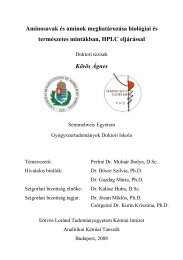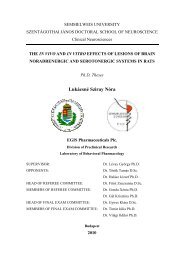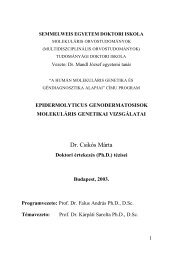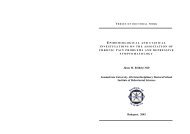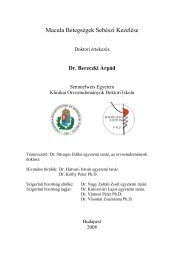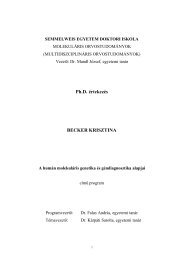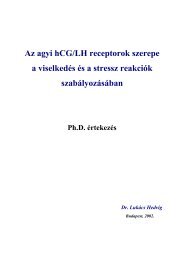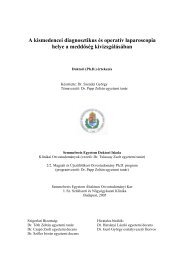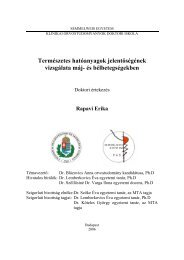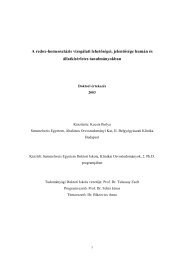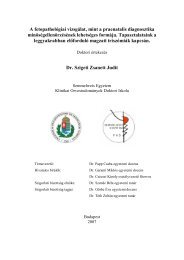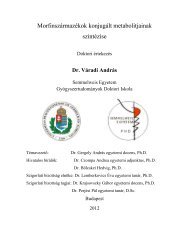New phytochemical data on Dracocephalum species - Semmelweis ...
New phytochemical data on Dracocephalum species - Semmelweis ...
New phytochemical data on Dracocephalum species - Semmelweis ...
You also want an ePaper? Increase the reach of your titles
YUMPU automatically turns print PDFs into web optimized ePapers that Google loves.
<str<strong>on</strong>g>New</str<strong>on</strong>g> <str<strong>on</strong>g>phytochemical</str<strong>on</strong>g> <str<strong>on</strong>g>data</str<strong>on</strong>g> <strong>on</strong> <strong>Dracocephalum</strong> <strong>species</strong><br />
Theses of the Ph.D. dissertati<strong>on</strong><br />
András Zoltán Kakasy<br />
<strong>Semmelweis</strong> University<br />
Doctoral School of Pharmaceutical Sciences<br />
Department of Pharmacognosy<br />
Supervisor:<br />
Prof. Dr. Éva Lemberkovics<br />
Budapest<br />
2006.
Ph.D. Thesis<br />
NEW PHYTOCHEMICAL DATA ON DRACOCEPHALUM SPECIES<br />
by András Zoltán Kakasy<br />
Supervised by Prof. Dr. Éva Lemberkovics<br />
Department of Pharmacognosy, Faculty of Pharmacy, <strong>Semmelweis</strong> University<br />
SUMMARY<br />
Most recent publicati<strong>on</strong>s relating to <strong>Dracocephalum</strong> <strong>species</strong> have discussed the phytochemistry<br />
and pharmacology of n<strong>on</strong>-volatile and volatile compounds with promising pharmacological effects, such as<br />
rosmarinic and caffeic acids, flav<strong>on</strong>oids with cytotoxic activity, or diterpenes with trypanocidal activity.<br />
The aim of our work was to c<strong>on</strong>tribute new results c<strong>on</strong>cerning the <str<strong>on</strong>g>phytochemical</str<strong>on</strong>g> characterizati<strong>on</strong> of some<br />
drag<strong>on</strong>head <strong>species</strong>.<br />
We have studied samples of D. moldavica L., D. ruyschiana L., D. argunense Fisch. ex Link, D.<br />
bipinnatum Rupr., D. diversifolium Rupr., D. grandiflorum L., D. peregrinum L., D. renati Emb. and D.<br />
rupestre Hance., all cultivated by ourselves.<br />
In the essential oil of D. renati Emb. by means of GC and GC-MS we detected m<strong>on</strong>oterpenes (lim<strong>on</strong><strong>on</strong>ene,<br />
carv<strong>on</strong>e, neral, geranial and linalyl acetate), methyl chavicol and sesquiterpenes (β-caryophyllene,<br />
caryophyllene oxide and bicyclovetivenol). The essential oil of D. ruyschiana L. c<strong>on</strong>tains mainly<br />
pinocamph<strong>on</strong>e and isopinocamph<strong>on</strong>e and smaller amounts of sesquiterpenes (β-caryophyllene,<br />
caryophyllene oxide, β-cubebene, germacrene-D and elemol), β-pinene, myrcene, lim<strong>on</strong>ene, p-cymene and<br />
methyl chavicol. The essential oil of D. grandiflorum L. was found to c<strong>on</strong>tain mainly sesquiterpenes<br />
(aromadendrene, β-caryophyllene, caryophyllene oxide, β-cubebene and β-bourb<strong>on</strong>ene) and carvacrol,<br />
together with smaller amounts of β-asar<strong>on</strong>e and methyl chavicol.<br />
As compared with <strong>species</strong> bel<strong>on</strong>ging in the Lamiaceae family, in which ursolic and oleanolic acids were<br />
detected in higher amounts (exceeding 3% and 1.5%, respectively), in the drag<strong>on</strong>head <strong>species</strong> we found<br />
<strong>on</strong>ly average quantities. Ursolic and oleanolic acids, measured by a GC method (after silylati<strong>on</strong>) were<br />
found in relatively high quantities in D. diversifolium Rupr. (0.81/0.25%) and D. peregrinum L.<br />
(0.72/0.26%) 1 .<br />
The main anthocyanidins of the purified and hydrolysed extract of D. moldavica L. (investigated by HPLC<br />
analysis) proved to be delphinidin and cyaniding; pelarg<strong>on</strong>idin was detected merely in traces. The GC-MS<br />
analysis of the c<strong>on</strong>stituents of the extracted matrix (before and after hydrolysis) of D. moldavica L. and D.<br />
ruyschiana L., in the form of their trimethylsilyl (oxime) ether/ester derivatives led to the identificati<strong>on</strong> and<br />
quantificati<strong>on</strong> of more than 30 newly identified c<strong>on</strong>stituents, including sugars, sugar alcohols, flav<strong>on</strong>oids,<br />
and aliphatic and aromatic carboxylic acids, together with their esters 2 .<br />
Phenoloids, such as rosmarinic acid (26.76 mg/g), tannins (11.2%) and flav<strong>on</strong>oids (0.5%) accumulate in D.<br />
moldavica L. in the early stages of <strong>on</strong>togeny. Higher quantity of caffeic acid (0.5 mg/g) and essential oil<br />
(0.40-0.83% v/m) were measured during flowering.<br />
An infusi<strong>on</strong> prepared from Moldavian drag<strong>on</strong>head herb c<strong>on</strong>tains large quantity of tannins and up to 20-30%<br />
of the phenolcarboxylic acids and flav<strong>on</strong>oids present in the herb. Alcohol, used as a solvent to prepare a<br />
tincture, dissolves primarily the essential oils of the herb. The main volatile terpenoid of the infusi<strong>on</strong> is<br />
geraniol, while in the tincture geranyl acetate predominates.<br />
We have established, that during the process of extracti<strong>on</strong> of Moldavian drag<strong>on</strong>head herb by supercritical<br />
carb<strong>on</strong> dioxide, oxygenated m<strong>on</strong>oterpenes are extracted at the beginning of the extracti<strong>on</strong> process; less<br />
volatile comp<strong>on</strong>ents and fatty acids were extracted later 3 .<br />
1. INTRODUCTION, AIMS<br />
1<br />
Janicsák, G., Veres, K., Kakasy, A., Máthé, I. (2006) Biochemical Systematics and Ecology, 34: 392-396.<br />
2<br />
Kakasy, A., Füzfai, Zs., Kursinski, L., Molnár-Perl, I., Lemberkovics, É. (2006) Chromatographia 63: S17-S22<br />
3<br />
Kakasy, A., Lemberkovics, É., Simándi, B., Lelik, L., Héthelyi, É., Antal, I., Szőke, É. (2006) Flavour and Fragrance<br />
Journal 21: 598-603.
The genus drag<strong>on</strong>head (<strong>Dracocephalum</strong>, Lamiaceae) c<strong>on</strong>tains some 70 <strong>species</strong>, which to date<br />
have been investigated primarily from the aspect of their essential oils. The Moldavian<br />
drag<strong>on</strong>head (D. moldavica L.), the most extensively studied <strong>species</strong> of the genus, is<br />
naturalized in this area of Europe as a cultivated medicinal plant. The essential oil<br />
compositi<strong>on</strong> of the <strong>species</strong> has been revealed in some detail, in c<strong>on</strong>trast with the knowledge<br />
<strong>on</strong> other substances in the herb. D. ruyschiana L. and D. austriacum L. are sp<strong>on</strong>taneous in<br />
Hungary, represented in the Hungarian flora by 30-40 specimens. This is a protected and<br />
endangered <strong>species</strong> throughout Europe.<br />
A survey of the literature <strong>on</strong> the essential oils of the drag<strong>on</strong>head <strong>species</strong> yields detailed <str<strong>on</strong>g>data</str<strong>on</strong>g><br />
<strong>on</strong> some 20 <strong>species</strong>. Recent publicati<strong>on</strong>s have discussed the phytochemistry and<br />
pharmacology of the n<strong>on</strong>-volatile and volatile compounds extracted from the drag<strong>on</strong>head<br />
<strong>species</strong>: e.g. rosmarinic and caffeic acids, lipophilic flav<strong>on</strong>oids with cytotoxic activity (D.<br />
kotschyi Boiss.), m<strong>on</strong>oterpene glycosides and diterpenes, which have trypanocidal activity (D.<br />
komarovi Lipsky), and antinociceptive essential oil comp<strong>on</strong>ents (D. kotschyi Boiss.).<br />
An extensive survey of the literature <strong>on</strong> the botanical, <str<strong>on</strong>g>phytochemical</str<strong>on</strong>g> and<br />
(ethno)pharmacological aspects of drag<strong>on</strong>head <strong>species</strong> aroused our interest in this genus. Our<br />
aim was to c<strong>on</strong>tribute original <str<strong>on</strong>g>phytochemical</str<strong>on</strong>g> research results to the <str<strong>on</strong>g>data</str<strong>on</strong>g> available <strong>on</strong> this<br />
genus.<br />
The primary aim of our work was to carry out an extended <str<strong>on</strong>g>phytochemical</str<strong>on</strong>g> survey <strong>on</strong> a large<br />
number of drag<strong>on</strong>head <strong>species</strong>. Besides Moldavian drag<strong>on</strong>head (chosen as the model <strong>species</strong><br />
of the genus) and the protected and endangered D. ruyschiana L., we planned to cultivated as<br />
many available <strong>species</strong> as possible. Unfortunately, the cultivati<strong>on</strong> of D. austriacum L. failed<br />
several times. An additi<strong>on</strong>al aim was to examine the compositi<strong>on</strong>s of some less well studied<br />
<strong>species</strong> (D. ruyschiana L., D. grandiflorum L. and D. renati Emb.) by GC and GC-MS<br />
methods and to detect and quantify two triterpene carboxylic acids (ursolic and oleanolic<br />
acids) in eight drag<strong>on</strong>head <strong>species</strong> by a GC method after silylati<strong>on</strong>. We also intended to detect<br />
and quantify rosmarinic and caffeic acids in the same <strong>species</strong> by TLC-densitometry. It seemed<br />
reas<strong>on</strong>able to examine the anthocyanins (a group of phenoloids with interesting biological<br />
activities) of selected <strong>species</strong> (D. moldavica L. and D. ruyschiana L.) by means of column<br />
chromatographic fracti<strong>on</strong>ati<strong>on</strong>, an electrophoretic survey, TLC, HPLC and GC-MS (after<br />
derivatizati<strong>on</strong>). The latter method seemed suitable for identificati<strong>on</strong> and quantificati<strong>on</strong> of<br />
further biologically active c<strong>on</strong>stituents, such as sugars, sugar alcohols, fatty acids, flav<strong>on</strong>oids,<br />
and aliphatic and aromatic carboxylic acids.
We set out to follow the quantitative fluctuati<strong>on</strong>s in some biologically active compound<br />
groups (volatile oils, aromatic carboxylic acids, total polyphenol, tannin and flav<strong>on</strong>oids) of D.<br />
moldavica L. during <strong>on</strong>togeny and to compare the amounts of these substances in samples<br />
collected in the same stage of the <strong>on</strong>togeny, but from cultures at different geographic sites.<br />
It is well known that the effect of a phytotherapeutic product is influenced c<strong>on</strong>siderably by the<br />
extracti<strong>on</strong> process, and our final aim was therefore to compare the influences of various<br />
extracti<strong>on</strong> methods (steam distillati<strong>on</strong>, traditi<strong>on</strong>al extracti<strong>on</strong> with organic solvents and<br />
supercritical extracti<strong>on</strong>) <strong>on</strong> the compositi<strong>on</strong>s of the essential oils obtained and to quantify the<br />
main active c<strong>on</strong>stituent groups in infusi<strong>on</strong>s and tinctures.<br />
2. MATERIALS AND METHODS<br />
2.1. Plant material<br />
Phytochemical analyses were carried out <strong>on</strong> samples of D. moldavica L. and D. ruyschiana<br />
L., cultivated in Baksa, Marosvásárhely/Tîrgu Mureş (Transylvania, Romania) and Vácrátót<br />
in 1999-2002. Samples of D. moldavica L. were gathered in well-determined stages of the<br />
<strong>on</strong>togeny. Samples of six further drag<strong>on</strong>head <strong>species</strong> (D. argunense Fisch. ex Link, D.<br />
bipinnatum Rupr., D. diversifolium Rupr., D. grandiflorum L., D. peregrinum L., D. renati<br />
Emb. and D. rupestre Hance.) were obtained from the collecti<strong>on</strong> of the Botanical Garden of<br />
the Institute of Ecology and Botany of the Hungarian Academy of Sciences in Vácrátót,<br />
Hungary in 1999. Seeds of D. renati Emb. and D. ruyschiana L. were obtained via seedexchange<br />
c<strong>on</strong>tracts (Copenhagen and Gießen).<br />
2.2. Microscopy<br />
Preparati<strong>on</strong>s (cross-secti<strong>on</strong>s of fresh leaves) were investigated with an Aksziszkop XL<br />
microscope. Different types of covering and glandular trichomes were recorded.<br />
2.3. Extracti<strong>on</strong> methods<br />
An infusi<strong>on</strong> and a tincture (using 80% ethanol) of D. moldavica L. herb were prepared<br />
according to the instructi<strong>on</strong>s of the Hungarian Pharmacopoeia (7 th editi<strong>on</strong>). Soxhlet extracts of<br />
the same plant material were made with n-hexane and ethanol as organic solvents. The main<br />
parameters of the supercritical fluid carb<strong>on</strong> dioxide extracti<strong>on</strong>: pressure 45 MPa, temperature
40 °C, flow rate of the solvent 7 kg/min., pressure in the first separator 8 MPa or 9 MPa, and<br />
pressure in the sec<strong>on</strong>d separator 2 MPa. We also performed fracti<strong>on</strong>ated extracti<strong>on</strong> by<br />
breaking off the extracti<strong>on</strong> process at predetermined time intervals (each 30 min from the<br />
beginning of the extracti<strong>on</strong> process). In this manner, we collected four successive fracti<strong>on</strong>s<br />
from the sec<strong>on</strong>d separator.<br />
Dried and powdered flower samples of D. moldavica L. were extracted with methanolacet<strong>on</strong>e<br />
1:1 acidified with hydrochloric acid (0.05% w/w). The extract obtained was purified<br />
<strong>on</strong> a Sephadex LH-20 column using a gradient eluent system (water → methanol). Each<br />
soluti<strong>on</strong> was acidified with hydrochloric acid (0.05% w/w). The major, intense violet fracti<strong>on</strong><br />
was freeze-dried.<br />
2.4. Qualitative and quantitative <str<strong>on</strong>g>phytochemical</str<strong>on</strong>g> analyses<br />
Essential oils were obtained by steam distillati<strong>on</strong>, using the apparatus official in the<br />
Hungarian Pharmacopoeia (7 th editi<strong>on</strong>), and quantified both volumetrically and<br />
gravimetrically. The compositi<strong>on</strong>s of the essential oils were analysed by GC and GC-<br />
MS. Main parameters: fused silica columns with the following stati<strong>on</strong>ary phases:<br />
enantioselective Rt-βDEXm, DB-1701 and MDN-5S, programmed temperature, and<br />
an electr<strong>on</strong> i<strong>on</strong> trap detector in the MS secti<strong>on</strong>. The relative standard deviati<strong>on</strong><br />
(RSD%) of the relative c<strong>on</strong>tent for each identified c<strong>on</strong>stituent was calculated from the<br />
<str<strong>on</strong>g>data</str<strong>on</strong>g> of three replicate analyses.<br />
Ursolic and oleanolic acids were detected and quantified in purified and silylated<br />
extracts by GC (a fused silica column with HP 5 as stati<strong>on</strong>ary phase, isothermal,<br />
internal standard: cholesteryl acetate).<br />
The presence of acylated anthocyanins in the purified and freeze-dried flower extracts<br />
was verified by means of an electrophoretic survey (paper electrophoresis).<br />
The sugar moieties of the anthocyanins (after acid hydrolysis of the freeze-dried<br />
fracti<strong>on</strong>s) and the acylating acids (detached from the sugar moieties of the glycoside)<br />
were identified by TLC methods, partly developed by ourselves.<br />
A porti<strong>on</strong> of the freeze-dried fracti<strong>on</strong> was subjected to acid hydrolysis. The soluti<strong>on</strong><br />
c<strong>on</strong>taining the aglyc<strong>on</strong>es was extracted and passed through a C18 SPE column.<br />
Analyses were performed <strong>on</strong> a Surveyor system (DAD detector). HPLC c<strong>on</strong>diti<strong>on</strong>s: a<br />
Phenomenex Luna (5 µm C18; 250x4.6 mm I.D.) column coupled with a SecurityGard<br />
C18 guard column, isocratic c<strong>on</strong>diti<strong>on</strong>s/gradient eluti<strong>on</strong>.
GC/MS analyses were carried out directly <strong>on</strong> the extracts (without Sephadex and SPM<br />
purificati<strong>on</strong>) and also after extract hydrolysis (2 M trifluoroacetic acid, 2 h, 4 h).<br />
C<strong>on</strong>stituents were identified and quantified as their trimethylsilyl (oxime) ether/ester<br />
derivatives, from a single run, <strong>on</strong> the basis of their total (TIC) and selective fragment<br />
i<strong>on</strong> (SIM) resp<strong>on</strong>ses. Calculati<strong>on</strong>s were related to the dry matter c<strong>on</strong>tents of the<br />
extracts.<br />
Rosmarinic and caffeic acids were detected and quantified in purified extracts by<br />
TLC-densitometry.<br />
The total flav<strong>on</strong>oid c<strong>on</strong>tent of D. moldavica L. herb was measured by means of the<br />
spectrophotometic method official in the German Pharmacopoeia (10 th editi<strong>on</strong>). The<br />
total polyphenol and tannin c<strong>on</strong>tents were quantified by the spectrophotometric<br />
methods official in the Hungarian Pharmacopoeia (7 th editi<strong>on</strong>).<br />
3. RESULTS AND DISCUSSION<br />
3.1. Microscopy<br />
We have described different types of covering trichomes (e.g. D. ruyschiana L.: tooth-like<br />
c<strong>on</strong>ical, D. grandiflorum L.: large, multicellular, with striated cuticle) and glandular<br />
trichomes (mainly Lamiaceous with 8 secretory cells) <strong>on</strong> the leaf surface of 13 drag<strong>on</strong>head<br />
<strong>species</strong>, with special emphasis <strong>on</strong> distinctive features.<br />
3.2. Essential oil compositi<strong>on</strong>s of D. renati Emb., D. grandiflorum L. and<br />
D. ruyschiana L.<br />
In the essential oil of D. renati Emb. (0.5% v/m), we identified 18.3% lim<strong>on</strong>ene and<br />
oxygenated m<strong>on</strong>oterpenes (carv<strong>on</strong>e 2.1%, neral 0.53%, geranial 0.65% and linalyl acetate<br />
0.74%), methyl chavicol (0.31%), and sesquiterpenes such as β-caryophyllene (1.07%),<br />
caryophyllene oxide (0.69%) and bicyclovetivenol (0.25%). The main comp<strong>on</strong>ent of the<br />
essential oil is an as yet unidentified compound (M + 150).<br />
A comm<strong>on</strong> feature of the <strong>species</strong> bel<strong>on</strong>ging in the subgenera <strong>Dracocephalum</strong> and Ruyschiana<br />
is their low essential oil c<strong>on</strong>tent, and this accords well with our measurements (0.08%<br />
essential oil in D. grandiflorum L.). The presence of sesquiterpene hydrocarb<strong>on</strong>s such as
aromadendrene (5.7%), β-caryophyllene (8.7%), caryophyllene oxide (11.7%), β-cubebene<br />
(3.2%) and β-bourb<strong>on</strong>ene (22.1%) is characteristic of the essential oil profile of D.<br />
grandiflorum L. Besides sesquiterpenes, carvacrol was identified in appreciable amount<br />
(13.4%), together with smaller quantities of other phenylpropane compounds such as β-<br />
asar<strong>on</strong>e, methyl chavicol and anethol. These <str<strong>on</strong>g>data</str<strong>on</strong>g> are in reas<strong>on</strong>able accord with the earlier<br />
classificati<strong>on</strong> of D. grandiflorum L., together with D. nutans L. and D. scrobiculatum Regel,<br />
into the chemotype where the essential oil is dominated by sesquiterpenes and m<strong>on</strong>oterpenes.<br />
Nevertheless, our results indicate that the phenylpropane compounds bel<strong>on</strong>g more to the<br />
profile of the essential oil of D. grandiflorum L. than m<strong>on</strong>oterpenes. The occurrence of<br />
methyl chavicol, anethol, β-cubebene, carvacrol, aromadendrene, caryophyllene oxide and β-<br />
asar<strong>on</strong>e in this essential oils is reported for the first time by ourselves.<br />
The predominant compounds in the essential oil of D. ruyschiana L. (0.23%) are oxygenated<br />
bicyclic m<strong>on</strong>oterpenes, such as pinocamph<strong>on</strong>e (43.6%) and isopinocamph<strong>on</strong>e (21.5%).<br />
Pinocamph<strong>on</strong>e has been identified as main c<strong>on</strong>stituent, together with isopinocamph<strong>on</strong>e in D.<br />
nutans L. and D. nodulosum Rupr., and with trans-pinocamph<strong>on</strong>e in D. fruticulosum Steph. ex<br />
Willd. Besides the main comp<strong>on</strong>ents, we have identified m<strong>on</strong>oterpenes: myrcene (3.12%),<br />
lim<strong>on</strong>ene (0.65%), p-cymene (1.5%) and β-pinene (0.89%); sesquiterpenes: β-caryophyllene<br />
(3.8%), caryophyllene oxide (1.6%), β-cubebene (1.6%), germacrene-D (3.6%) and elemol<br />
(4.4%); and a phenylpropane: methyl chavicol (0.62%).<br />
The essential oil compositi<strong>on</strong>s of D. ruyschiana L. and D. renati Emb. and the new<br />
c<strong>on</strong>stituents of the essential oil of D. grandiflorum L. are reported for the first time in this<br />
paper.<br />
3.3. Ursolic and oleanolic acid c<strong>on</strong>tents of some drag<strong>on</strong>head <strong>species</strong><br />
Both triterpenoid acids were detected in all investigated drag<strong>on</strong>head <strong>species</strong>. As compared<br />
with <strong>species</strong> bel<strong>on</strong>ging in the family Lamiaceae and the subfamily Nepetoideae, in which<br />
ursolic and oleanolic acids were detected in higher amounts (exceeding 3% and 1.5%,<br />
respectively), in the drag<strong>on</strong>head <strong>species</strong> we measured <strong>on</strong>ly average quantities. These two<br />
acids, measured by a GC method (after silylati<strong>on</strong>), were found in relatively higher quantities<br />
in D. diversifolium Rupr. (0.81/0.25%), D. peregrinum L. (0.72/0.26%) and D. ruyshiana L.<br />
(0.67/0.24%).<br />
3.4. Identificati<strong>on</strong> and quantificati<strong>on</strong> of rosmarinic and caffeic acids
Rosmarinic acid was detected in all investigated drag<strong>on</strong>head <strong>species</strong>. In comparis<strong>on</strong> with<br />
Melissa officinalis L., official in the Hungarian Pharmacopoeia (8 th editi<strong>on</strong>), with a total<br />
hydroxycinnamic acid derivative c<strong>on</strong>tent expressed in terms of rosmarinic acid of not less<br />
than 40 mg/g, <strong>on</strong>ly D. moldavica L. (28.45 mg/g), D. renati Emb. (21.28 mg/g) and D.<br />
argunense Fisch. ex Link (18.45 mg/g) c<strong>on</strong>tain rosmarinic acid in c<strong>on</strong>centrati<strong>on</strong>s of the same<br />
order of magnitude. With the excepti<strong>on</strong> of D. bibinnatum Rupr. and D. argunense Fisch. ex<br />
Link., in each of the investigated drag<strong>on</strong>head <strong>species</strong> caffeic acid was detected in measurable<br />
amount, but in much lower quantity than rosmarinic acid (e.g. D. grandiflorum L. 5.13 mg/g<br />
rosmarinic acid and 1.14 mg/g caffeic acid).<br />
3.5. Anthocyanins<br />
The main anthocyanidins identified in the purified and hydrolysed D. moldavica L. flower<br />
extract by HPLC (spectral analysis, authentic standards) proved to be delphinidin and<br />
cyanidin, while pelarg<strong>on</strong>idin was detected <strong>on</strong>ly in traces.<br />
From the electrophoretic mobility (2-2.3 cm) of the extracted pigments, it can be c<strong>on</strong>cluded<br />
that the anthocyanins of D. moldavica L. (flower and stem) and D. ruyschina L. (flower) are<br />
aclyted <strong>on</strong> the sugar moiety. By means of TLC methods, we detected glucose and rhamnose<br />
as the sugar moieties of anthocyanins, and p-coumaric acid and malic acid as the acylating<br />
acids of the sugar moieties.<br />
3.6. Further n<strong>on</strong>-volatile c<strong>on</strong>stituents in D. moldavica L. (flower and stem) and D.<br />
ruyschiana L. (flower)<br />
GC-MS analysis of the c<strong>on</strong>stituents of the extracted matrices (before and after hydrolysis) of<br />
D. moldavica L. and D. ruyschiana L., in the form of their trimethylsilyl (oxime) ether/ester<br />
derivatives resulted in the identificati<strong>on</strong> and quantificati<strong>on</strong> of more than 30 c<strong>on</strong>stituents,<br />
quantitated partly via their TIC and partly via their SIM resp<strong>on</strong>ses.<br />
Identificati<strong>on</strong>/quantificati<strong>on</strong> proved to relate to a total of 35-69% (expressed as the dry matter<br />
c<strong>on</strong>tent of the extracts).<br />
Identified as main c<strong>on</strong>stituents were aliphatic (succinic, malic, tartaric and citric acids) and<br />
aromatic carboxylic acids (chlorogenic, caffeic, ferulic, 3,4-dihydroxyphenyllactic,<br />
rosmarinic, hydroxybenzoic, trimethoxybenzoic and vanillic acids), together with their<br />
corresp<strong>on</strong>ding esters (ferulic acid-3,4-dihydroxyphenyllactic acid ester), saccharides<br />
(arabinose, rhamnose, glucose, galactose, disaccharides and tetrasaccharides), sugar alcohols
and acids (levulinic acid, arabitol, galactur<strong>on</strong>ic acid and inositol), fatty acids (palmitic, stearic<br />
and margarinic acids), apigenin and luteolin flav<strong>on</strong> aglyc<strong>on</strong>es and tocopherol, phosphoric acid<br />
and quinic acid. As result of hydrolysis, the amounts of some c<strong>on</strong>stituents (succinic acid,<br />
citric acid, trimethoxybenzoic acid, arabinose, glucose and galactur<strong>on</strong>ic acid) increased, due<br />
to the cleavage of the glycosidic linkages of saccharides and the decompositi<strong>on</strong> of esters.<br />
The apigenin c<strong>on</strong>tent of the extract of D. ruychiana L. is <strong>on</strong>ly the <strong>on</strong>e-tenth of to the amount<br />
measured in the flower extract of the D. moldavica L. sample. Even in the hydrolysed sample<br />
(0.035%), it proved to be <strong>on</strong>e-twentieth of the corresp<strong>on</strong>ding value measured in the<br />
hydrolysed extract of D. moldavica L. (0.76%). At the end of the hydrolysis, luteolin and<br />
apigenin could not be detected, presumably because of their decompositi<strong>on</strong>. Unfortunately,<br />
the presence of the anthocyanidins could not be c<strong>on</strong>firmed by GC-MS, very probably since<br />
they are present in c<strong>on</strong>centrati<strong>on</strong>s below the detecti<strong>on</strong> limits of our measurements: < 0.01%,<br />
expressed as a percentage of the dry matter c<strong>on</strong>tent of the extract.<br />
The accuracy of the process (including extracti<strong>on</strong>, derivatizati<strong>on</strong> and GC-MS quantitati<strong>on</strong>),<br />
characterized by the RSD% values of the c<strong>on</strong>stituents, proved to be < 5 RSD% in the case of<br />
the major c<strong>on</strong>stituents (present in > 1%) and 5-10 RSD% for the minor c<strong>on</strong>stituents (< 1%).<br />
3.7. Quantitative fluctuati<strong>on</strong> of the main phenoloids and volatile terpenoids of<br />
<strong>Dracocephalum</strong> moldavica L. during <strong>on</strong>togeny<br />
Phenoloids such as rosmarinic acid (26.76 mg/g), tannins (11.2%) and flav<strong>on</strong>oids (0.5%)<br />
accumulate in D. moldavica L. in the early stages of <strong>on</strong>togeny. Higher quantities of caffeic<br />
acid (0.5 mg/g) and essential oil (0.40-0.83% v/m) were measured during flowering. The herb<br />
can be c<strong>on</strong>sidered a valuable tannin source when collected before flowering. Caffeic acid<br />
reaches its maximum level during full flowering (0.5 mg/g). Independently of the placement<br />
of cultures (with noteworthy climatic differences), the highest essential oil c<strong>on</strong>tent was<br />
measured in samples collected during flowering. On comparing the essential oil c<strong>on</strong>tents of<br />
samples gathered in the same phase of the <strong>on</strong>togeny, but from cultures at different geographic<br />
sites, we c<strong>on</strong>cluded that higher the elevati<strong>on</strong>, the better is the essential oil producti<strong>on</strong> of<br />
culture.
3.8. Selectivity of extracti<strong>on</strong> methods<br />
Boiling water, used as a solvent to prepare the infusi<strong>on</strong> of the Moldavian drag<strong>on</strong>head herb,<br />
dissolves nearly the whole quantity of tannins, and up to 20-30% of the phenolcarboxylic<br />
acids, flav<strong>on</strong>oids and essential oil c<strong>on</strong>tained by the herb. Ethanol (80%), used as a solvent to<br />
prepare a tincture, dissolves 68% of the essential oil, 27.6% of the total flav<strong>on</strong>oids, 46.5% of<br />
the tannins, 3.3% of the rosmarinic acid and 2.3% of the caffeic acid c<strong>on</strong>tained by the herb.<br />
The main volatile terpenoid in the infusi<strong>on</strong> is geraniol, while that in the tincture is geranyl<br />
acetate.<br />
From a comparis<strong>on</strong> of the yields and selectivities of different extracti<strong>on</strong> methods<br />
(hydrodistillati<strong>on</strong>, extracti<strong>on</strong> with organic solvents, and SFE) referred to the amounts of<br />
extracted volatile terpenoids, the c<strong>on</strong>clusi<strong>on</strong> can be drawn that the selectivity is inversely<br />
proporti<strong>on</strong>al to the yield. During the process of extracti<strong>on</strong> of Moldavian drag<strong>on</strong>head herb by<br />
supercritical carb<strong>on</strong> dioxide, oxygenated m<strong>on</strong>oterpenes are extracted at the beginning of the<br />
extracti<strong>on</strong> process; less volatile comp<strong>on</strong>ents and fatty acids are extracted later.
4. ACKNOWLEDGEMENTS<br />
I am indebted to Prof. Éva Szőke, Director of the Department of Pharmacognosy at<br />
<strong>Semmelweis</strong> University, who provided the facilities for me to prepare my Ph.D. work.<br />
I wish to express my gratitude to Prof. Éva Lemberkovics, supervisor of my Ph.D. work, for<br />
her magnanimous guidance and for her c<strong>on</strong>tinuous professi<strong>on</strong>al and human encouragement.<br />
I would like to thank Prof. Ágnes Kéry, Dr. László Kursinszki, Dr. Gabriella Marczal,<br />
Éva Héthelyi, Kálmán Ditrói, Dr. Andrea Balázs and Dr. Mária Then for their<br />
professi<strong>on</strong>al guidance, and the staff of the Department of Pharmacognosy at <strong>Semmelweis</strong><br />
University – especially Boross-Szabados – for their support.<br />
I am pleased to take this opportunity to thank members of other universities and departments:<br />
Prof. Imre Máthé, Dr. Gábor Janicsák, Dr. Vilmos Miklóssy-Vári,<br />
Dr. Miklós Galántai † , Prof. Ibolya Molnár-Perl, Zsófia Füzfai, Dr. Béla Simándi, Dr.<br />
György Stampf, Dr. Zoltán Kisgyörgy † , Prof. Árpád Gyéresi and Prof. Károly Csedő,<br />
who all c<strong>on</strong>tributed so much to the present work.<br />
I am grateful to my parents, to my sister and her family, and to my friends for their unbroken<br />
encouragement.<br />
This work was supported financially by a scholarship of the Hungarian Ministry of<br />
Educati<strong>on</strong>, by the Hungarian Academy of Sciences (OTKA T.30034; F. 029249) and<br />
GVOP tender 3.1.1.-2004-05-0397/3.0.
5. REFERENCES<br />
5.1. Publicati<strong>on</strong>s in the topics of the Ph.D. work<br />
Articles<br />
Kakasy, A., Lemberkovics, É., Kursinszki, L., Janicsák, G., Máthé, I., Szőke, É. (2000)<br />
Adatok a <strong>Dracocephalum</strong> moldavica L. fitokémiai értékeléséhez. Orvostudományi értesítő<br />
73: 410-417.<br />
Kakasy, A., Lemberkovics, É., Kursinszki, L., Janicsák, G., Szőke, É. (2002) Data to the<br />
<str<strong>on</strong>g>phytochemical</str<strong>on</strong>g> evaluati<strong>on</strong> of Moldavian Drag<strong>on</strong>head (<strong>Dracocephalum</strong> moldavica L.,<br />
Lamiaceae). Herba Pol<strong>on</strong>ica 48: 112-119.<br />
Lemberkovics, É., Kéry, Á., Simándi, B., Kakasy, A., Balázs, A., Héthelyi, É., Szőke É.<br />
(2004) Extrakciós módszerek hatása az illóolajok összetételére. Acta Pharmaceutica<br />
Hungarica 74: 166-170.<br />
Héthelyi, É., Szarka, Sz., Kakasy, A., Galambosi, B., Szőke, É., Lemberkovics, É. (2005)<br />
<strong>Dracocephalum</strong> <strong>species</strong>ek illóolajának kémiai karaktere. Olaj, szappan, kozmetika 54: 75-81.<br />
Kakasy, A., Lemberkovics, É., Simándi, B., Lelik, L., Héthelyi, É., Antal, I., Szőke, É.<br />
(2006) Comparative study of traditi<strong>on</strong>al essential oil and supercritical fluid extracts of<br />
Moldavian Drag<strong>on</strong>head (<strong>Dracocephalum</strong> moldavica L.). Flavour and Fragrance Journal 21:<br />
598-603. (If: 0,648)<br />
Kakasy, A., Füzfai, Zs., Kursinski, L., Molnár-Perl, I., Lemberkovics, É. (2006) Analysis of<br />
n<strong>on</strong>-volatile c<strong>on</strong>stituents in <strong>Dracocephalum</strong> <strong>species</strong> by HPLC and GC/MS. Chromatographia<br />
63: S17-S22 (If: 1,145)<br />
Janicsák, G., Veres, K., Kakasy, A., Máthé, I. (2006) Study of the oleanolic and ursolic acid<br />
c<strong>on</strong>tents of some <strong>species</strong> of the Lamiaceae. Biochemical Systematics and Ecology 34: 392-<br />
396. (If: 0,704)<br />
Oral presentati<strong>on</strong>s and posters<br />
Kakasy, A., Lemberkovics, É., Kursinszki, L., Janicsák, G., Máthé, I., Szőke, É. (2000) A<br />
<strong>Dracocephalum</strong> moldavica L. fenoloidjainak értékmérése. <strong>Semmelweis</strong> Egyetem Doktori<br />
Iskola, II. Ph. D. Tudományos Napok, Budapest. Abstract: Book of Abstracts p. 61.<br />
Kakasy, A., Lemberkovics, É., Janicsák, G., Kursinszki, L., Máthé, I., Szőke, É. (2000)<br />
Adatok a <strong>Dracocephalum</strong> moldavica L. fitokémiai értékeléséhez. Erdélyi Múzeum Egyesület<br />
Orvostudományi és Gyógyszerészeti Szakosztály X. Tudományos Ülésszaka,<br />
Székelyudvarhely, Romania. Abstract: Book of Abstracts p. 26.<br />
Kakasy, A., Kursinszki, L., Bihátsi-Karsai, É., Lelik, L., Janicsák, G., Máthé, I., Szőke, É.,<br />
Lemberkovics, É. (2000) Phytochemical evaluati<strong>on</strong> of <strong>Dracocephalum</strong> moldavica L. by<br />
chromatographic methods. 2 nd Internati<strong>on</strong>al Symposium <strong>on</strong> Chromatography of natural<br />
products, Lublin – Kazimierz Dolny, Poland. Abstract: Book of Abstracts p. 26
Kakasy, A., Janicsák, G., Kursinszki, L., Szőke, É., Lemberkovics, É. (2000) Phytochemical<br />
analysis of <strong>Dracocephalum</strong> moldavica L. „Plante medicinale – realizări şi perspective”, Piatra<br />
Neamţ, Romania. Abstract: in Acta Phytoterapica Romanica 6: 62-63.<br />
Kakasy, A., Janicsák, G., Kursinszki, L., Szőke, É., Lemberkovics, É. (2000) Quantitative<br />
variati<strong>on</strong> of phenoloids and volatile terpenoids of <strong>Dracocephalum</strong> moldavica L. during<br />
<strong>on</strong>togeny. Lippay János & Vas Károly Scientific Symposium, Budapest. Abstract: Book of<br />
Abstracts p. 204-205<br />
Lemberkovics, É., Kéry, Á., Simándi, B., Kristó, TSz., Kakasy, A., Szőke, É. (2001) Effect<br />
of extracti<strong>on</strong> methods <strong>on</strong> the compositi<strong>on</strong> of essential oils. World C<strong>on</strong>ference <strong>on</strong> Medicinal<br />
and Aromatic Plants, Budapest. Abstract: Book of Abstracts p. 38<br />
Lemberkovics, É., Kéry, Á., Simándi, B., Kakasy, A., Szőke, É. (2002) Influence of<br />
extracti<strong>on</strong> methods <strong>on</strong> the compositi<strong>on</strong> of essential oils. 33 rd Internati<strong>on</strong>al Symposium <strong>on</strong><br />
Essential Oils, Lisb<strong>on</strong>, Portugal. Abstract: Book of Abstracts p. 116<br />
Lemberkovics, É., Kéry, Á., Simándi, B., Kakasy, A., Szőke, É. (2002) Quality of traditi<strong>on</strong>al<br />
and supercritical extracts from essential oil plants. Medicinal plant research and utilizati<strong>on</strong>.<br />
10 th Nati<strong>on</strong>al C<strong>on</strong>ference <strong>on</strong> Medicinal Plants/8 th Nati<strong>on</strong>al C<strong>on</strong>ference <strong>on</strong> Drug Research/5 th<br />
Nati<strong>on</strong>al C<strong>on</strong>ference <strong>on</strong> Phytotherapy. Kecskemét, Hungary. Abstract: Book of Abstracts p.<br />
102, 203<br />
Kakasy, A., Simándi, B., Lemberkovics, É., Szőke, É. (2003) A moldvai sárkányfű<br />
(<strong>Dracocephalum</strong> moldavica L.) herbájából különböző extrakciós módszerekkel kiv<strong>on</strong>t<br />
illóolajok összetételének vizsgálata. <strong>Semmelweis</strong> Egyetem Doktori Iskola, V. Ph.D.<br />
Tudományos Napok, Abstract: Book of Abstracts p. 58-59<br />
Kakasy, A., Lemberkovics, É., Marczal, G., Simándi, B., Szőke, É. (2003) A moldvai<br />
sárkányfű (<strong>Dracocephalum</strong> moldavica L.) illóolajának és szuperkritikus extraktumainak<br />
összehas<strong>on</strong>lító vizsgálata. C<strong>on</strong>gressus Pharmaceuticus Hungaricus XII., Budapest.<br />
Abstract: in Gyógyszerészet, (special issue 2003): 74.<br />
Kakasy, A,, Lemberkovics, É,, Balázs, A., Kursinszki, L., Janicsák, G., Szőke, É. (2003)<br />
Extracti<strong>on</strong> and <str<strong>on</strong>g>phytochemical</str<strong>on</strong>g> investigati<strong>on</strong> of the essential oil and phenoloids of Moldavian<br />
Drag<strong>on</strong>head (<strong>Dracocephalum</strong> moldavica L.). 45 th Annual Meeting of the Hungarian Society<br />
of Gastroenterology, Balat<strong>on</strong>aliga, Hungary.<br />
Abstract: in <str<strong>on</strong>g>New</str<strong>on</strong>g>sletter of the Hungarian Society of Gastroenterology 12: 97.<br />
Kakasy, A., Marczal, G., Héthelyi, É., Lemberkovics, É. (2004) <strong>Dracocephalum</strong> fajok<br />
mikromorfológiai és fitokémiai jellemzése. A gyógynövénykutatás aktuális kérdései 2004. Az<br />
MGyT Gyógynövény Szakosztályának, a Magyar Biológiai Társaság Botanikai<br />
Szakosztályának és az MTA Növénykémiai-Kemotax<strong>on</strong>ómiai Munkabizottságának közös<br />
előadóülése, Budapest.<br />
Lemberkovics, É., Kakasy, A., Böszörményi, A., Balázs, A., Héthelyi, É., Simándi, B., Kéry,<br />
Á., Szők, É. (2005) Influence of technological and biological c<strong>on</strong>diti<strong>on</strong>s <strong>on</strong> essential oil<br />
compositi<strong>on</strong>. 36 th Internati<strong>on</strong>al Symposium <strong>on</strong> Essential Oils, Budapest. Abstract: Programme<br />
and Book of Abstracts p. 7
Kakasy, A., Füzfai, Zs., Kursinszki, L., Molnár-Perl, I., Lemberkovics, É. (2005) Analysis of<br />
n<strong>on</strong>-volatile c<strong>on</strong>stituents in <strong>Dracocephalum</strong> moldavica L., D. ruyschiana L. and D.<br />
ruyschiana L. by GC-MS and HPLC methods. 6 th Balat<strong>on</strong> Symposium <strong>on</strong> High-Performance<br />
Separati<strong>on</strong> Methods, Siófok. Abstract: Book of Abstracts p. 30<br />
Kakasy, A., Janicsák, G., Veres, K., Lemberkovics, É. (2005) Triterpene and<br />
phenolcarboxylic acids in <strong>Dracocephalum</strong> <strong>species</strong>. 1 st BBBB C<strong>on</strong>ference <strong>on</strong> Pharmaceutical<br />
Sciences, Siófok. Abstract: Book of Abstracts p.<br />
Janicsák, G., Veres, K., Kakasy, A., Máthé, I. (2005) Az oleánol- és urzolsav mennyiségi<br />
visz<strong>on</strong>yai a Lamiaceae családban. Gyógynövények napjaink gyógyszerészetében – tradíciók<br />
és újd<strong>on</strong>ságok. 11 th Hungarian C<strong>on</strong>ference <strong>on</strong> Medicinal Plants, Dobogókő, Hungary.<br />
Abstract: Programme and Book of Abstracts p. 52.<br />
5.2. Publicati<strong>on</strong>s in related topics<br />
Article<br />
Lemberkovics, É., Kéry, Á., Simándi, B., Kristó, TSz., Kakasy, A., Szőke, É. (2001)<br />
Evaluati<strong>on</strong> of supercritical plant extracts <strong>on</strong> volatile and n<strong>on</strong> volatile biologically active<br />
lipophil comp<strong>on</strong>ents. Internati<strong>on</strong>al Journal of Horticultural Science 7(2): 78-83.<br />
Article published in proceeding book<br />
Lemberkovics, É., Kéry, Á., Simándi, B., Kakasy, A., Szőke, É. (2003) Effect of extracti<strong>on</strong><br />
methods <strong>on</strong> the compositi<strong>on</strong> of essential oils. In: Proceedings of the Internati<strong>on</strong>al C<strong>on</strong>ference<br />
<strong>on</strong> Medicinal and Aromatic Plants Part II. (Acta Horticulturae 597) Eds.: É. Szőke, I. Máthé,<br />
G. Blunden, Á. Kéry. p. 49-56.<br />
Oral presentati<strong>on</strong><br />
Lemberkovics, É., Kéry, Á., Simándi, B., Kakasy, A., Czinner, E., Szőke, É. (2003)<br />
Comparative study <strong>on</strong> supercritical extracts of aromatic plants. The 3 rd Word C<strong>on</strong>gress <strong>on</strong><br />
Medicinal and Aromatic Plants for Human Welfare, Chiang-Mai, Thailand. Abstract: Book of<br />
Abstracts p. 363



